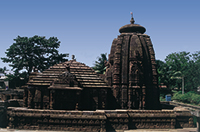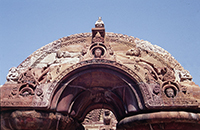Bhubaneswar Tourist Place Or Places to Visit in Bhubaneswar
Bhubaneswar “The Lord of the Universe” is studded with hundreds of temples and is popularly known as the “Temple City” or the “Cathedral City” of the East. This abode of Shiva or Tribhubaneswar, the “Lord of the Three Wrods”, is one of the most important Hindu pilgrim centres. It is believed that the city one had about 7000 temples of which 500 still exist. These shrines are a gentle remainder of the splendour of ancient India. Bhubaneswar, the ancient capital of the Kalinga Empire is today the modern capital of Orissa.
Bhubaneswar City
Orissa’s capital emerged in the 7th century as a center of prolific and accomplished temple building, and by the 11th century the city of Bhubaneswar (derived from Shiva’s incarnation as Tribhubaneswar, Lord of the Three Worlds) had become a significant religious hub, with an estimated 7,000 temples. Of these, only several hundred remain, but those that survive reveal the evolution of the Nagara style into an architectural form unique to Orissa. You won’t need to stay here more than a day Konark’s Sun Temple, one of India’s top attractions, is just under an hour’s drive away.
In the heart of Bhubaneswar’s Old Town, the most important temples almost all Shaivite—are clustered around Bindusagar Lake, a holy reservoir believed to hold water from each and every holy river and lake in India. Of the 7,000 temples that are said to have once surrounded the tank, only around 500 remain. Traditionally, pilgrims perform their ablutions in the lake before heading into the temples to perform puja (a ritual of respect, such as prayer). The best are easily visited in a morning (more than three or four is overkill), leaving you time to explore some of the outlying sights during the afternoon.
The best of the city’s Nagara-style temples (7th c. and 12th c. A.D.) are testament
to both a radical resurgence of Hinduism and Buddhist defeat—frequently represented
in temple sculptures by the image of a lion lunging for an elephant. With the
exception of wonderful Rajarani Temple (see below), all of those worth visiting are
living temples. The best are magnificently carved Mukteshwar Temple—the 10thcentury
“Gem of Orissan Architecture,” where a squat, cobra-protected lingam stands in the sanctum sanctorum—and Lingaraj Temple; although the complex is offlimits
to non-Hindus, you can admire it from a well-known vantage point, a raised
platform built by the British, where you’ll be harassed by a hood with a phony register
of donations from other foreigners (ignore his advances and mention the police).
If you have time, make a stop at the well-preserved 7th-century Parasurameswar
Temple (Brahmeswar), for its lavish carvings, including a number of amorous couples.
For something more “exotic,” visit Vaital Temple and view its creepy tantric
carvings; you’ll need a flashlight to see the images of humans being put to death while
the goddess Chamunda looks on.
Bhubaneswar India
Bhubaneswar is situated between 21°15' North (Latitude) and 85°15' (Longitude) at an altitude of 45m above the sea level. Geographically is it situated in the eastern coastal plains of Orissa and south-west of the river, Mahanadi. Bhubaneswar is subdivided into a number of townships and housings. National Highway-5 that once bordered the city now runs right through it. It is one of the 100 largest cities on Earth.
Bhubaneswar Climate
The average temperature in the summers can be as high as up to 40°C. The summers are quite pleasant with minimum temperature being almost around 16°C. During the monsoon, Bhubaneswar receives an approximately 1450mm. of rainfall. The best time to visit the city is during the months of October to April.
Bhubaneswar History
It was a small town before it became the capital in 1948. Today Bhubaneswar is a modern administrative centre and the seat of Utkal University and Orissa Univerisity of Agriculture and Technology. There are rolling mills and wire-cable works. The city has an airport. Settlements date back to the reign of Ashoka (3rd century BC). The capital of the Kesari dynasty of Orissa (5th - 10th century BC) was here. Bhubaneswar, a religious centre, once had 7000 shrines around its sacred lake; the remains of 500 still stand, displaying many styles of Hindu and Buddhist art and architecture. The Lingaraja temple is the most famous and imposing temple of Orissa. There are fine chlorite images of Ganesha, Parvati and Skanda. The city was devastated by a cyclone in October 1999.
Bhubaneswar Tourist Place
Bhubaneswar ('The Lord of the Universe') is the capital of Orissa. In Bhubaneswar, Shiva is known as Tribuhuvaneswara or "Lord of the Three Worlds", from which the city derives its name. Beside being the capital of ancient Kalinga, Bhubaneswar is known as Temple Town and Cathedral City on account of its many temples in the extravagant Orissan style. Modern Bhubaneswar is delightfully rural for a state capital that administers the affairs of 25 million Orissans.
Khandagiri and Udayagiri
The twin hills of Kumargiri and Kumarigiri known as Khandagiri and Udayagiri, about 8km from the city of Bhubaneswar contain varieties of rock-cut caves, built mainly for the jain monks around 1st and 2nd century B.C. The thirteen years lithic record of king Kharavela engraved in Hatigumpha (elephant cave) is a magnificent specimen of Pali records so far found in India.
Dhauli
Surrounded by paddy fields, the Dhauli hill brings back memories of the historic 'Kalinga war' which was fought here. It is the city of Bhubaneswar that 'Ashoka, the terrible', was transformed into 'Ashoka, the compassionate', who championed the cause of Buddhism. On the foot of the hill, one can see the Rock Edicts of Ashoka and the forepart of a skillfully sculpted elephant hewn out of a huge rock.
Dhauli has gained prominence due to the establishment of a Buddhist Peace Pagoda, popularly known as Shanti Stupa, built in the early seventies by the Japan Buddha Sangha and Kalinga Nippon Buddha Sangha. An old temple of Lord Dhavaleswar, reconstructed in 1972, also stands on the hill-top.
The glistening, white-domed Shanti Stupa (Peace Pagoda) at the top of Dhauli Hill is visible from the main road as you head toward this site where historic Ashokan rock edicts are carved. Guarded by pale yellow Ashokan lions, the Kalinga World Peace Pagoda is a celebration of Ashoka’s decision, 2,300 years ago, to renounce violence and war and embrace Buddhism—a decision made in the wake of his massacre against the Kalinga people, then rulers of Orissa. A plaque here notes that Ashoka built 84,000 stupas (commemorative cairns), some as far away as Greece.
Hirapur
About 15km from Bhubaneswar, Hirapur has the 11th century hypaethral temple of sixty four yoginis. Atri Situated amidst greenery and famous for the hot sulphur water spring, Atri, 42km from Bhubaneswar and 14km from Khurda, is also a holy place with the shrine of Hatakeswar. A bath in the spring water is reputed to cure skin diseases.
Nandankanan
Picturesquely carved out of the Chandaka forest, Nandankanan is a biological park where animals are kept in their natural habitat. It is about 20km from the main city. A centrally located lake divides the zoo from the Botanical Gardens. Tigers, Lions, Clouded Leopards, Black Panthers, European Brown Bear, Himalayan Black Bear, Gharials, Rosy Pelican, etc. are among the chief attractions of the zoo, which is famous for its White Tigers.
Cactus Garden
Situated close to the 'Ekamara Kanan' in Bhubaneswar, the Cactus Garden, with its huge collection of cacti should not be missed by tourists.
Bhubaneswar Temples
Lingaraja Temple
The 11th century temple dedicated to Lord Shiva, as Lingaraja is the culmination of Orissa style of temple architecture. The temple set in a walled compound is noted for its imposing 54 metres high spire, dominating the skyline of the town. The main sanctum surrounded by about 150 subsidiary shrines has a unique hari hara lingam – half Shiva and half Vishnu. A large number of devotees visit the shrine, especially during Shivaratri festival (February – March).
Parasuramesvera Temple
The Shiva temple built around 650Ad in classical style is the city’s oldest surviving temple. It is noted for the finely detailed bas-reliefs depicting elephant and horse processions and Shiva images.
Mukteswar Temple
The small 10th century shrine regarded as the ‘Gem of Orissan architecture’ bridges the early and later phases of the kalinga school of architecture. In front of the shrine is a stunningly beautiful archway.
Raja Rani Temple
The beautiful 11th century shrine amidst a well laid out garden is graced by erotic carvings and some of the finest Orissan temple sculptures. Surrounded by open space and paddy fields, this 11thcentury
temple—maintained by the Archaeological Survey of India—glimmers in the
light of day, built as it was using a superior-quality burgundy-gold sandstone. Unusual
for Orissan temples, the tower (shikhara) features miniature versions of itself. Sculptural
representations of lotus flowers with the guardians of the eight cardinal directions
are a standout feature of the temple walls, which also feature delightful female
figures engaged in mundane (but beautiful) daily activities.
Vaital Temple
The temple built in 800 AD was used mainly for tantric worship, which centred around Shakti worship. A ‘four faced’ linga with unusual carvings is set in front of the entrance to the sanctum. The first erotic sculptures known in Orissan art are found here.
Handicrafts Museum
A rich variety of Orissan handicrafts – stone sculpture, patta paintings, brass castings, horn toys and silver filigree etc are displayed here.
Orissa State Museum
It exhibits a fine collection of sculptures, coins, copper plates, stone inscriptions, armours, rare palm-leaf manuscripts, Bronze Age tools, natural history, geological objects, paintings, anthropological specimens and traditional folk and musical instruments etc. Orissa State Museum This collection convincingly explains the religious context of Hindu sculptures, but you may be more fascinated by the erotic friezes that date
back as far as the 7th century A.D. Upstairs, the Manuscript Gallery includes early
examples of the type of work you’ll encounter in some Orissan crafts villages. Along
with a collection of musical instruments, a number of dioramas depict different
Orissan tribes. Next door is a collection of patachitra (cloth) paintings dealing primarily
with the Jagannath cult and tales from the Ramayana.
Cactus Garden
The beautiful garden near ‘Ekamar kanan’ has a large collection of Cactii and is a worth visiting site.
Bhubaneswar Festivals
Makar Mela
Makar Sankranti is celebrated with gusto in mid-January when the Sun enters the orbit of Capricorn. Sun God is worshipped with great fervor and enthusiasm by one and all. The festival can be best enjoyed at Kalijai (an island in Chilika), Atri, Ghatgaon, Keonjhar, Jashipur and Jagatsinghpur.
Megha Mela
The most popular and colorful festival of Konark, an occasion for a grand congregating of Indian pilgrims and enthusiasts from abroad, falls on the 7th day of the brigh half of 'Magha'. The Indian pilgrims take dips in the Chandrabhaga Tirtha near the sea and welcome the rising Sun with prayers.
Museum of Tribal Art and Artefacts
Anything and everything connected with the life of Orissa’s tribal people is on display in the exhibition rooms at this newly built museum decorated with primitive murals. Traditional costumes, jewelry, household appliances, and hunting equipment such as bows and arrows, axes, and traps for birds and fish indicate the ways of life of the tribal peoples of Orissa.
 |
 |
Bhubaneshwar City Distance Guide |
|
| Balangir | 303 Km |
| Bhawani Patna | 428 Km |
| Baripada | 295 Km |
| Baleshwar | 240 Km |
| Chhatrapur | 145 Km |
| Cuttack | 45 Km |
| Dhenkanal | 80 Km |
| Koraput | 466 Km |
| Kendujhargarh | 262 Km |
| Konark | 69 Km |
| Puri | 52 Km |
| Paradwip | 123 Km |
| Phulbani | 205 Km |
| Raurkela | 320 Km |
| Sambalpur | 290 Km |
| Sundargarh | 376 Km |
